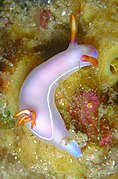Hypselodoris bullockii
| Hypselodoris bullockii | |
|---|---|

| |
| Hypselodoris bullockii from Bima bay (Sumbawa, Indonesia) | |
| Scientific classification | |
| Domain: | Eukaryota |
| Kingdom: | Animalia |
| Phylum: | Mollusca |
| Class: | Gastropoda |
| Order: | Nudibranchia |
| Family: | Chromodorididae |
| Genus: | Hypselodoris |
| Species: | H. bullockii
|
| Binomial name | |
| Hypselodoris bullockii (Collingwood, 1881)[1]
| |
| Synonyms[2] | |
| |
Hypselodoris bullockii is a species of colourful sea slug or dorid nudibranch, a marine gastropod mollusc in the family Chromodorididae.[2][3]
Hypselodoris bullockii is quite pale purple in colour.[4] It has been mistaken for a number of other species.[5] These include the closely related species Hypselodoris variobranchia and Hypselodoris violacea as well as the unrelated species Hypselodoris iba. Hypselodoris apolegma, which looks similar to this species (and is distinguished by a reticulate pattern gradually merging in to the pinkish purple [6][7]), was previously assumed to be possibly a different colour form of H. bullockii.[7] However, molecular phylogenetic data confirm the distinction of the many species.[5][8]
Distribution
This nudibranch was described from a specimen measuring 70 mm (2.8 in) in length, dredged in 110 m (360 ft) at Recruit Island, Senkaku Islands, 150 miles NE of Taiwan, 25°55′22″N 124°33′30″E / 25.922745°N 124.558247°E. It is currently identified with an animal which is widespread in shallow water in the central Indo-Pacific region. Many records are incorrect as it has now been shown that at least eight species have been confused under this name in the past. The H. bullockii clade contains seven species, plus H. iba is a mimic of H. bullocki. Six of these can be found in the Philippines. Hypselodoris apolegma is found throughout the western Pacific from Japan (Okinawa), the Philippines, Indonesia Malaysia (Sabah) whereas H. brycei, is found only in Western Australia (Houtman Abrolhos Islands to the Exmouth Region and Dampier Archipelago). Hypselodoris bullockii is considered to be widespread in the western and central Pacific, from Japan, Taiwan, Hong Kong, the Philippines, Indonesia, Malaysia, eastern Australia, the Marshall Islands and New Caledonia, whereas H. melanesica is known only from Papua New Guinea and the Solomon Islands, both of which are areas where H. bullockii is absent. Hypselodoris rositoi is apparently restricted to the northern Philippines and H. violacea is apparently restricted to Sabah, Malaysia and Palawan Island, Philippines. Hypselodoris variobranchia is apparently restricted to Japan (Okinawa), Taiwan, the Philippines, Malaysia, Indonesia and Queensland, Australia.[5]
-
Two Hypselodoris bullockii of different sizes
-
Hypselodoris bullockii
References
- ^ Collingwood, C. 1881. On some new species of nudibranchiate Mollusca from the eastern seas. Transactions of the Linnean Society of London, Zoology, series 2, 2(2):123-140, pls. 9-10.
- ^ a b Bouchet, P.; Caballer, M. (2012). Hypselodoris bullockii. Accessed through: World Register of Marine Species at http://www.marinespecies.org/aphia.php?p=taxdetails&id=560043 on 2012-06-11
- ^ Rudman W.B. (1995) The Chromodorididae (Opisthobranchia: Mollusca) of the Indo-West Pacific: further species from New Caledonia and the Noumea romeri colour group. Molluscan Research 16: 1-43. page(s): 41
- ^ Gosliner, T.M., Behrens, D.W. & Valdés, Á. (2008) Indo-Pacific Nudibranchs and seaslugs. A field guide to the world's most diverse fauna. Sea Challengers Natural History Books, Washington, 426 pp. page(s): 267
- ^ a b c Epstein, H. E.; Hallas, J. M.; Johnson, R. F.; Lopez, A.; Gosliner, T. M. (2018). Reading between the lines: revealing cryptic species diversity and colour patterns in Hypselodoris nudibranchs (Mollusca: Heterobranchia: Chromodorididae). Zoological Journal of the Linnean Society. 2018, XX, 1–74. With 40 figures.
- ^ Yonow N. (2012) Opisthobranchs from the western Indian Ocean, with descriptions of two new species and ten new records (Mollusca, Gastropoda). ZooKeys 197: 1–129. [22 May 2012]
- ^ a b [1] Archived 21 October 2007 at the Wayback Machine Hypselodoris apolegma (Yonow, 2001). Sea Slug Forum. Accessed 10 February 2009
- ^ Johnson R.F. & Gosliner T.M. (2012) Traditional taxonomic groupings mask evolutionary history: A molecular phylogeny and new classification of the chromodorid nudibranchs. PLoS ONE 7(4): e33479
External links
- Photos of Hypselodoris bullockii on Sealife Collection


